| CONTRAFACTA AND TRANSCRIBED MOTETS: VERNACULAR INFLUENCES ON LATIN
MOTETS AND CLAUSULAE IN THE FLORENCE
MANUSCRIPTその4 |
| S T I
R P S I E S S E / V I R G A CULTUS , QUA NT RE VIENT/ L ’ AUTR
IER JOUER AND FLOS FILIUS E[IUS] 3 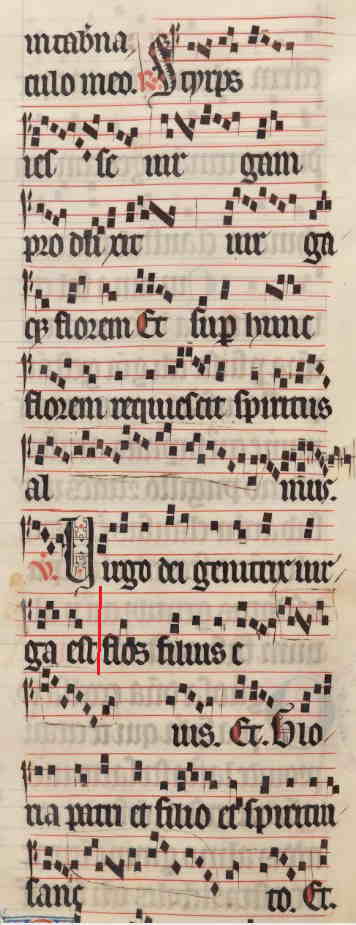 responsory Stirps Iesse(latin 15182 fol.304) Stirps lesse virgam produxit virgaque florem Et super hunc florem requiescit spiritus almus Virgo Dei genetrix virga est, flos filius eius Et super Gloria patri et filio et spiritui sancto Requiescit The three-voice clausula Flos filius e[ius] 3 is unique to F and has a related Latin double motet in the same manuscript, Stirps Iesse/Virga cultus/FLOS FILIUS E[IUS], also unique to F. This clausula and Latin motet in F are part of a large family of pieces that shares the same musical material, variously associated with a number of different Latin and French texts. The extant incarnations of Flos filius e[ius] 3 are as follows (the order does not imply a chronology): Flos filius e[ius] 3 の3パートクラウズラは、F写本のみに存在し、同じ写本に、3声ラテン語モテットStirps Iesse/Virga cultus/FLOS FILIUS E[IUS],を有している(これもF写本のみ)。F写本中のこのクラウズラとラテン語モテットは、同じ素材を共有する大きなグループの一部である。こうした素材は、多くの異なったラテン語、フランス語歌詞とさまざまに連関している。Flos filius e[ius] 3の現存するincarnationは以下である(年代史的順には並んでいない)。
The French texts Quant revient and L’autrier jouer are transmitted together in five difference sources, and are most commonly associated with the music of Flos filius e[ius] 3. Furthermore, as Anderson has emphasised, the two-voice motet Candida virginitas/FLOS FILIUS EIUS, extant in W2 and LoC, is evidently a contrafactum modelled on the text L’autrier jouer, rather than on Virga cultus or Virgo viget melius.115 フランス語歌詞Quant revient and L’autrier jouerは、5つの異なった資料によって広く知れ渡っている。そして多くはFlos filius e[ius] 3の音楽と連関している。さらに、Andersonが強調しているように、2声モテットCandida virginitas/FLOS FILIUS EIUS(W2写本、Loc写本に現存)は明らかにVirga cultus あるいは Virgo viget meliusではなく、L’autrier jouerをモデルにしたcontrafactumである。115 注115) This is confirmed by the marginal incipit ‘Autrier jour’ copied at the beginning of Candida virginitas in W2, fol. 145v このことは、W2写本fol. 145vのCandida virginitasの最初の部分に書写されている欄外の書き込み ‘Autrier jour’によって確かめられている(訳注;下譜)。 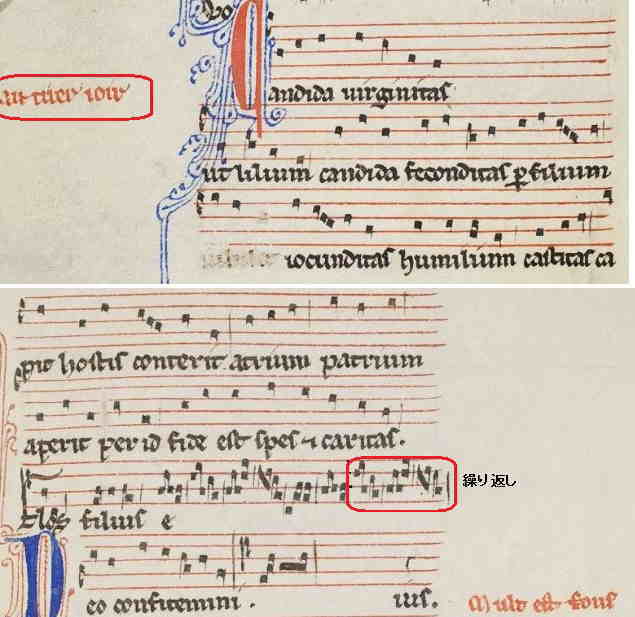 2声モテットCandida virginitas/FLOS FILIUS EIUS(W2, fols. 145v‐146r ) Flos filius e[ius] 3 and its related motets have received considerable scholarly attention. Yet, aside from the brief analysis of this clausula by Wolf Frobenius116, the assumed conventional progressions from clausula to motet and from Latin text to French contrafactum have not otherwise been questioned. Flos filius e[ius] 3と その関連したモテットには多くの学者たちの注目が集まっている。 Wolf Frobeniusによるこのクラウズラの簡便な分析116とは別に、すでに想定されている、クラウズラからモテットへという伝統的な流れは別の面においても、疑問視されている。117 注116) Frobenius cites the presence of a refrain melody and the repetition of the tenor melisma on EIUS as evidence of French motet priority. Yvonne Rokseth had previously included Flos filius e[ius] 3 on a list of eleven three-voice clausulae that she proposed as possible sketches for motets (‘canevas de motets’). Such ‘sketch’ clausulae technically still pre-date their related motets, but their conception and function are atypical. Frobenius はrefrainの旋律の存在とEIUSにおけるtenorのメリスマの繰り返しを、フランス語モテットのpriorityの証明として引用している。Yvonne Roksethは、以前より、 Flos filius e[ius] 3 を11個の3声クラウズラのリストに含めていた。こうしたクラウズラは、彼女が「モテットのスケッチ(としてのクラウズラ)(‘canevas de motets’)」として提案したものである。こうした「スケッチ」クラウズラは、テクニカルな面からみれば、関連したモテットに先立って書かれたものであるが、この概念と機能は非典型的である。 注117) When discussing motets related to Flos filius e[ius] 3, Anderson assumed that the Latin double motet in F must be the ‘original’ version. See his The Latin Compositions in Fascicules VII and VIII of W2, pt. 1, p. 102. A clausula-Latin motet-French motet progression is also presumed by Sylvia Huot. See her Allegorical Play in the Old French Motet: The Sacred and the Profane in Thirteenth-Century Polyphony (Stanford, Calif., 1997), pp. 95‐6. Rothenberg, in a recent textual analysis of this motet family (The Flower of Paradise, pp. 39‐49), was careful to avoid assumptions about the relative chronology of motet versions. However, he stated that this motet family ‘originated with a three-voice clausula in the Florence manuscript’ (p. 39). Flos filius e[ius] 3に関連した複数のモテットを議論しながら、Andersonは、F写本中のラテン語の3声モテットはオリジナル版でなければならない、と主張した。クラウズラ→ラテン語モテット→フランス語モテットという流れはまた、Sylvia Huotによっても推察されている。Rothenbergは、最近のこのモテットグループについての歌詞分析において、モテット版の相関的な年代史についての仮定については、慎重になっている。しかしながら彼は、このモテットグループは、F写本における3声クラウズラが起源である、と主張している。 Everist discusses Stirps Iesse/Virga cultus/FLOS FILIUS E[IUS] and Quant revient/L’autrier jouer/FLOS FILIUS EIUS in detail in French Motets in the Thirteenth Century, 118and this motet family is also the main focus of Alejandro Enrique Planchart’s 2003 article, ‘The Flower’s Children’. Neither scholar seems to have doubted the priority of the clausula, Flos filius e[ius] 3. Everistは、Stirps Iesse/Virga cultus/FLOS FILIUS E[IUS] と Quant revient/L’autrier jouer/FLOS FILIUS EIUSとを論じ、このモテットグループはまた、 Alejandro Enrique Planchartの 2003年の記事‘The Flower’s Children’の主要課題であるとした。どんな学者も、クラウズラFlos filius e[ius] 3のpriorityを疑うようには、見えなかった。 注118) See Everist, French Motets in the Thirteenth Century, pp. 43‐51, 66‐8. Everist discusses the Latin and French texts and the refrain associated with this double motet. Everistは、ラテン語、フランス語モテット、およびこの3声モテットに連関したrefurainについて論じている。 While Everist is cautious about the relative chronology of its related motets, Planchart is strongly in favour of Stirps Iesse/Virga cultus/FLOS FILIUS E[IUS] as the earliest texting of the clausula,his preference based on the unreliable hypothesis that this Latin motet most closely tropes the tenor chant. Everistが、関連するモテットの相関的年代史について慎重であった間、Planchartは、ラテン語モテットStirps Iesse/Virga cultus/FLOS FILIUS E[IUS]が、もっとも初期のクラウズラへの歌詞付けであると強く考えていた。彼の好みは、このラテン語モテットがtenor chantをもっともtropeしているというあてにならない仮定を前提としていた。 Planchart takes no account of the presence of a widely transmitted refrain melody, ‘C’est la fin, la fin, que que nus die j’amerai ’ (vdB 338) in this clausula and its motets. By contrast, both Everist and Clark, as already noted, cite ‘C’est la fin, la fin’ as an important example of a clausula-derived refrain, which, as Everist suggests, may initially have been associated with a Latin text. Planchartは、このクラウズラ、モテット群において広く入り込んでいたrefrain旋律C’est la fin, la fin, que que nus die j’amerai ’ (vdB 338)の存在についてはあまり考えていなかった。対照的に、Everist とClarkは、すでに論じたように、クラウズラ由来のrefrain(Everist が示したように、もともとはラテン語歌詞と関連していた)のうちでもっと重要な例としてC’est la fin, la fin’を引用した。 Notational and musical features of Flos filius e[ius] 3 invite a challenge to the conventional chronological model underlying Planchart’s analysis and Everist’s proposal concerning the origins of refrain 338. Flos filius e[ius] 3 の記譜法的、音楽的特徴は、Planchart’の分析と refrain338‘C’est la fin, la fin, que que nus die j’amerai ’の起源に関するEveristの提案とを裏付ける従来的時代史モデルへの挑戦を誘い出す。 Stirps Iesse/Virga cultus/FLOS FILIUS E[IUS] is placed near the end of the second motet fascicle of F, in close proximity to other possible Latin contrafacta of French motets. This Flos filius e[ius] motet family exhibits characteristics also shared with the family of Amo[ris] motets discussed above. Stirps Iesse/Virga cultus/FLOS FILIUS E[IUS] は、F写本の第二モテット冊子の最後に近い部分にあるが、フランス語モテットのラテン語contrafactaである可能性が非常に高い。このFlos filius e[ius] モテットグループはまた、これまでに論じられたAmo[ris]グループのモテットと共通する特徴を持っている。 Not only does F preserve a unique clausula and a unique Latin motet version, but it is once again texts in the vernacular that are most frequently found in association with the musical material. F写本は、この写本唯一のクラウズラとラテン語モテット版を保存しているだけでなく、音楽素材に関連してもっとも頻繁に見受けられる世俗語歌詞をもまた担うことになるのである。 Musically, Flos filius e[ius] 3 is strongly characterised by the ‘small-note ornaments or embellishments’ typical of newly composed French motets, but relatively unusual in the context of clausulae, and difficult to express in sine littera notation.121 クラウズラFlos filius e[ius] 3は、音楽的には、新たに作られたフランス語モテットに典型的な、‘small-note ornaments or embellishments’によって特徴づけられる。しかし、クラウズラとしてはそれは一般的ではないし、sine littera記譜法にてそれらを表現することは、困難である。 注121) Baltzer admitted that notational irregularities in clausulae could be ‘caused by exactly the kind of small-note ornaments or embellishments found in motets, much less typical in the general clausula repertory’. She subsequently drew a parallel more specifically between these embellishments and French motets. Baltzerは、「クラウズラ類の記譜的不規則性は、モテットにおいて見られるsmall-note ornaments or embellishmentsの類によるものであり、一般的なクラウズラのレパートリーにおいて典型的なことではない」と述べている。引き続き彼女は、こうした装飾とフランス語モテットの間の特殊な関係に目を向けている。 The clausula tenor lacks syllable marks and the corresponding text is not presented at the appropriate moments in the tenor chant: the words ‘Flos filius e’ are simply placed at the beginning of the clausula. The final syllable ‘-ius’ of ‘eius’ was never copied, nor is there a syllable stroke to indicate where it should have been placed. クラウズラのtenorは、シラブルマークが欠けており、それに相当する歌詞はtenor chantの適当なところに位置していない。‘Flos filius e’の言葉は、単純に、クラウズラの最初に置かれている。‘eius’の最後のシラブル‘-ius’は書写されず、それがどこに存在するのかを示唆するシラブルstrokeもない。 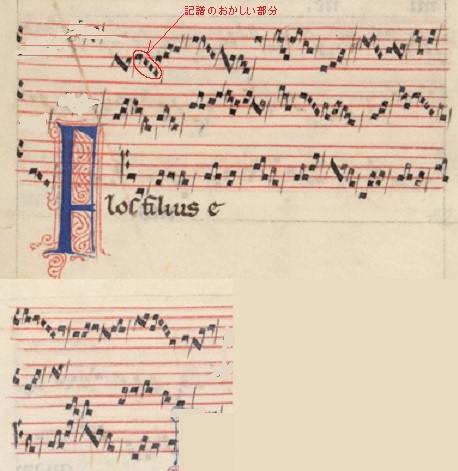 クラウズラ Flos filius e[ius] 3: 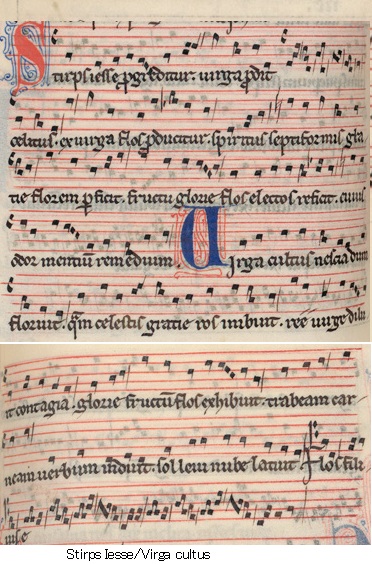 3声モテット An initial attempt to show the relationship of the three voices to one another using lines to mark the corresponding ordines seems swiftly to have been abandoned. Ordo lines in the triplum and duplum quickly cease to appear (though two are present in both upper voices in the opening phrase of the clausula), probably because the duplum and the triplum voices are poorly aligned throughout. 互いに対応する部分を目印にする線を使って、3声間の関係を示す初期の試みは、速やかに廃棄されたように見える。 triplumとduplum の音符の連続した流れ(Ordo lines)は、すぐになくなってしまう。(なおもクラウズラのオープニングフレーズにおける両上声部に2つ存在しているが)。おそらくその理由は,duplumと triplumの声部は全体にわたり、うまく整理されていないからである。 Notationally, the clausula is occasionally problematic. The ligation of perfections 32‐4 of the duplum, for example, appears to be erroneous (see Example 7, where the conventional alternative is shown directly underneath the duplum). Hans Tischler has commented on the notational ambiguity of this clausula, and Edward Roesner concurs, stating that Flos filius e[ius] 3 contains ‘extensive fractio modi, expressed in notation that is sometimes equivocal and capable of sustaining several different interpretations of the rhythmic detail’ 記譜法からすれば、クラウズラにはいくつかの問題がある。 。たとえば、perfections 32‐4のligationは誤りであるように見える。Hans Tischlerは、このクラウズラの記譜法のあいまいさをしてきしている。Edward Roesnerは、Flos filius e[ius] 3は広範囲なfractio modi,(訳注;the long into two breves)を含んでいることに同意し、リズムの詳細にさまざまな違った解釈があるあいまいさを持つ記譜法について述べている。 .Roesner’s statement is confirmed by comparing the differing readings of this sine littera notation offered by Planchart (see Example 7) and by Roesner himself (see Example 8). Roesnerの意見は、Planchartによって提案されあるいはRoesner自身によったsine littera記譜法への違った読み方を比較することにより、確認することができる。 This clausula displays, therefore, the hallmarks of a transcribed French motet: its notation is equivocal, the tenor is not properly texted and lacking in syllable marks, and the musical fabric is more characteristic of a newly composed French motet than a clausula. このクラウズラはそれゆえ、 transcribeされたフランス語モテットの hallmarkを示すことになる。その記譜法はあいまいであり、tenorはきちんと歌詞づけがなされておらず、シラブルマークを欠いており、その音楽のありようは、クラウズラというよりも、新しく作られたFrench motetの性格をより良く示している。127 注127) Waite did not propose this clausula to be a transcribed motet (see The Rhythm of Twelfth-Century Polyphony, p. 101). This is surprising, for Flos filius e[ius] 3 meets exactly the criteria by which he identified other clausulae as transcribed motets. Significantly, all of the clausulae identified by Waite as transcribed motets are two-voice pieces. It seems, therefore, that Waite overlooked, or did not consider, the small collection of three-voice clausulae in F as possible candidates. Waiteは、このクラウズラをtranscribed motetとしては提案していない。これは驚くべきことである。なぜなら、Flos filius e[ius] 3は、彼がtranscribed motetとして他のクラウズラ群を同定する際に使った基準に、正確に合致しているからである。それはつまり、Waiteによって(transcribed motetとして)同定されたクラウズラのすべては、2声作品である、ということである。それゆえ、Waiteは、F写本中の数少ない3声クラウズラ作品を、その候補としては、見逃したか、あるいはあえて考えなかったのだろう。 Significantly, Flos filius e[ius] 3 and Stirps Iesse/Virga cultus/FLOS FILIUS E[IUS] bear a strong resemblance to the clausula‐motet pair Amo[ris] 2 and Veni, salva nos/AMO[RIS], not only in their patterns of manuscript dissemination and concordance. Just like Amo[ris] 2 and Veni, salva nos, the copies of Flos filius e[ius] 3 and Stirps Iesse/Virga cultus in F are very closely related. Flos filius e[ius] 3 とStirps Iesse/Virga cultus/FLOS FILIUS E[IUS]の関係は、Amo[ris] 2 と Veni, salva nos/AMO[RIS],というクラウズラ‐モテットペア関係にきわめてよく似ている。それは、写本伝搬のパターンや(内容の)一致性だけではない。Amo[ris] 2 と Veni, salva nosの(関係の)ように、Flos filius e[ius] 3 のcopyとStirps Iesse/Virga cultusは密接に関係しているのである。 Flos filius e[ius] 3 and Stirps Iesse/Virga cultus agree almost entirely as to pitch, and seem to have been copied either in conjunction or from the same exemplar. Planchart also noted this close correspondence between the clausula and motet in F. Assuming a clausula-to-motet progression, he argued that ‘the clausula exemplar for the motet version was precisely the clausula as copied in F’. Flos filius e[ius] 3 と Stirps Iesse/Virga cultusは、音高はほぼすべて一致している。両者は同じ模範から続いて書写されたものと考えられる。Planchartもまた、クラウズラとモテットの間のこの密接な相同性を言っている。クラウズラ→モテット進化論を論じて、彼は「モテット版のためのクラウズラの模範は、F写本中のコピーとしてのクラウズラそのものであった」と論じている。 Yet, as in the relationship between Amo[ris] 2 and Veni, salva nos, a number of rhythmic variants exist between Flos filius e[ius] 3 and Stirps Iesse/Virga cultus. Variations in rhythm between the F clausula and motet on FLOS FILIUS E[IUS] are more numerous and significant than those found in the clausula and motet on AMO[RIS]. しかしながら、Amo[ris] 2 と Veni, salva nosとの関係のように、Flos filius e[ius] 3 と Stirps Iesse/Virga cultusとの間には多くのリズムの変化がある。FLOS FILIUS E[IUS]によるクラウズラとモテットのリズム上の変化は、 AMO[RIS]によるクラウズラ、モテット上のそれよりも大きい。 Despite notational ambiguities in the Flos filius e[ius] clausula, there are occasions when, in whatever ways one interprets the precise rhythmical details, a conventional reading of the clausula ligation clearly places a certain note at the beginning of a rhythmic perfection when this is not the case in the related motet. Flos filius e[ius] の記譜上のあいまいさにも関わらず、どのような方法でリズムの詳細を解釈しようが、従来的なクラウズラligationの読み方が、関連したモテットにおいては見られなくても、rhythmic perfectionの最初において、確かな音符を位置付ける機会がある。 At the opening of the triplum, for example, the clausula ligation indicates that the third perfection has to begin with the pitch c. This note is placed at the end of a ligature, therefore it must fall at the beginning of a perfection, as it does in both Planchart and Roesner’s transcriptions of perfections 2‐3 (marked in Examples 7 and 8 respectively; see also the facsimile of F, fol. 11r in Figure 1 below). triplumのオープニングにおいては、たとえば、クラウズラのligationでは、第3perfectionはDo音で始まるべきである。(が実際は)この音符は、ligatureの最後に置かれている。そのために、そのDo音は、Planchart とRoesnerの perfections 2‐3 による現代譜のように、perfectionの始めに位置しなければならない。 The Latin motet in F, however, clearly incorporates this c as part of a melisma on the syllable -gre of ‘progreditur’, with the result that it cannot possibly be placed at the beginning of a perfection (marked in Example9). F写本中のラテン語モテットはしかしながら、はっきりと、このDo音を‘progreditur’の-greシラブルのメリスマの一部として扱っている(Example9参照)。 This forces a different reading of this phrase from the related clausula. The difference in F between the Latin motet and the clausula, explicit in both their respective notations, results in what Planchart describes as a change in ‘vertical sonority’. これは、関連したクラウズラからのこのフレーズの異なった読み方を強いることになる。F写本中のラテン語モテットとクラウズラの相違は、それぞれの記譜にて明白であり、Planchartが‘vertical sonority’の変更として記述したことの結果である。 Differences of vertical sonority between clausula and motet versions occur, not only at the opening of the triplum, but also at the beginning of a perfection on five further occasions. Example9 indicates variant clausula sonorities, as interpreted by both Planchart and Roesner, above the relevant staves of the Latin motet. クラウズラとモテット版におけるvertical sonorityの相違は、triplumのオープニングのみならず、さらに5か所のperfectionの最初の部分にもまた認められる。Example9は、Planchart と Roesnerによって解釈された、クラウズラのさまざまなsonorityの変更を示している(ラテン語モテットの該当部分の上に訂正された譜が書かれている)。 The change in vertical sonority at perfection 34 is produced by Planchart’s extended reading of the ending of the clausula (see Example 7). Roesner also has f at the beginning of perfection 34 of the clausula duplum, rather than the e in the Latin motetus. Roesner believed the clausula e to be erroneous and therefore corrected it to f (see Example 8). See also Planchart’s discussion of Roesner’s transcription in ‘The Flower’s Children’, pp. 317.‐18. perfection 34におけるvertical sonorityの変更は、クラウズラの最後部分のPlanchartの拡大解釈によるものである。(see Example 7) Roesnerもまたこの部分のduplumにおいて、ミをファに置き換えている。 Such disagreements in ‘vertical sonority’ are difficult to explain if one accepts Planchart’s proposition that the motet in F was copied from the related clausula in the same manuscript. F写本中のモテットは同じ写本中の関連したクラウズラから書写されたものであるというPlanchartの説(訳注;クラウズラ→モテット)を受け入れるのであれば、こうしたvertical sonorityの違いは、その説明が困難なこととなる。 One would have to conclude that the rhythmic and harmonic character of the clausula was actively altered in its related Latin motet, directly contradicting certain unambiguous rhythmic information provided by the clausula. やはり、(本来は)クラウズラによってもたらされたはずのあいまいではないリズム情報とはもろに矛盾していることで、、クラウズラのリズムとハーモニーの性質は、その関連したラテン語モテットによって積極的に変えられてしまった(訳注;わかりにくい記譜になってしまった)、という結論に達せざるを得ない(訳注;モテット→クラウズラ)。 While Norman Smith has demonstrated that slight rhythmic changes could be made to clausulae in the process of creating motets, none of Smith’s examples is so drastic as this one. Norman Smithは、モテットが形成される過程において、クラウズラに若干の変化がもたらされたと主張するが、彼の挙げる例では、この例ほどに劇的なものではない。 It is hard to justify the proposition that rhythmic adjustments were made to the Flos filius e[ius] 3 clausula simply in order to accommodate motet texts: the variant rhythms in the motet do not have a dramatic impact on the text setting, and the extant Latin (or French) motet texts could have been fitted to the rhythms implied in the clausula without any need for the addition or removal of notes. The changes to the vertical sonority of the clausula, then, would seem an unusual and a high price to pay for a relatively small textual gain. モテットの歌詞に適合させるためにFlos filius e[ius] 3クラウズラのリズム変更が行われた(訳注;クラウズラ→モテット説に合わせようとして)、と仮定することは、困難である。モテットにおけるさまざまなリズムは歌詞に対してドラマチックなインパクトを与えることはなく、ラテン語(ないしはフランス語)モテット歌詞は、何ら音符を新たに付け加えたり、消去することなく、もともとクラウズラに包含されているリズムに適合しているのである。クラウズラのvertical sonorityの変更は、そうであれば、比較的小さな利益を得るために支払うべき尋常ではない高い価値があるように見える。 In addition, it is perplexing that the creator of the motet in F should have been so faithful to the pitches of the clausula, while conversely treating its rhythmic details with freedom, effecting changes that altered the harmonic character of the borrowed musical material. さらに加えて、(もしもクラウズラ→モテットであるならば)F写本におけるモテット制作者がクラウズラの音高に忠実であったかどうかは何とも言えない。逆にリズムの細部を自由に扱い、借りてきた音楽材料のハーモニーの性格に変化をもたらしていたかもしれない。 These changes in vertical sonority are significant in the light of Roesner’s observation (in ‘Who ‘‘Made’’ the Magnus liber ?’, p. 257) that, in organa subject to considerable variation in melodic profile, the ‘overall contrapuntal framework’ remains remarkably stable from version to version. Roesner notes that, despite significant melodic changes, ‘tenor/duplum simultaneities’ (p. 254) are largely unaltered. こうしたvertical sonorityにおける変更は、 Roesnerにおいて詳細である。そこにおいては、「melodic profileのさまざまな変化に従うオルガヌムにおいては、”全体的な対位法的構造”が版から版へと受け継がれている」、と書かれている。Roesnerは、大きなメロディの変更にもかからわらず、tenorとduplumの同時性は大きく変化することはない、と述べている。 Significantly, all other French and Latin motet versions of this music correspond with the vertical sonorities of the Latin motet in F rather than those of the clausula. If these motets were the offspring of the Flos filius e[ius] 3 clausula it would be curious that this large family of motets should rely on, and consistently reproduce, misreadings of its clausula model. 重要なことは、この音楽グループ( Flos filius e[ius] 3関連)に属する他のすべてのフランス語、ラテン語モテット版もまた、クラウズラよりもむしろF写本中のラテン語モテットのvertical sonoritiesと一致することである。もしもこれらのモテット群がFlos filius e[ius] 3 クラウズラの子孫であったとしたら、こうした大きなモテットグループが、クラウズラモデルの誤読に依存していたり、こうした誤読を常に再生産していることになってしまうだろう(だが実際はそうではない)。 This would also assume a clausula‐motet relationship entirely dependent on written notation, for an aural memory of the Flos filius e[ius] 3 clausula, were it pre-existent, would surely have prevented its widespread corruption in related motets. これはまた、クラウズラ‐モテットの関係が筆写された記譜に依存しているだろう、ということになる。なぜなら、その昔のように、Flos filius e[ius] 3 クラウズラの耳で聴いた記憶は、関連したモテットの崩壊を確かに防ぐからである。(訳注;耳で聞いてでの言い伝えならば、”誤記”は発生しない)。 The opposite hypothesis seems more convincing: as in the case of Amo[ris]2, the Flos filius e[ius] 3 clausula represents a transcription of a cum littera motet. This would explain irregular notational features of the clausula, also accounting for the consistency of pitch between the clausula and motet version in F in combination with discrepancies in rhythm. It is almost impossible to show all of the rhythms clearly implied in the motets in sine littera clausula notation. Amo[ris]2,ケースに見られるような、もっと極端な理由もあるようだ。Flos filius e[ius] 3クラウズラは、cum littera(歌詞つき)モテットからのtranscriptionを示している(訳注;すなわちモテット→クラウズラ)。これはこのクラウズラの不規則な記譜法の特徴を説明することだろう。また、クラウズラとモテット版の、リズム上の齟齬に対する音高の一致をもまた説明する。(訳注;cum litteraの場合、sine litteraほどリズムがはっきりしていないため、誤記が起こりやすい)。sine litteraクラウズラの記譜法を取るモテットにおいては、そこに含まれているすべてのリズムを示すことは、ほとんど不可能である。 The beginning of the triplum Stirps Iesse discussed above, for example, would have been very difficult to transcribe in ligatures without abandoning the passing note d on the syllable -gre.To notate this opening phrase sine littera either the d must be omitted or the rhythm of the motet slightly altered. Stirps Iesseモテットのtriplumの最初は、たとえば、シラブル-gre上の経過音レ音を捨て去ることなしに、ligatureをtranscribeすることは困難である。このオープニングフレーズを記譜するためには、sine littera(訳注;sine litteraによる記譜、すなわち、モテット→クラウズラ)か、あるいはレ音が省略されるか、あるいはモテットのリズムが若干でも変更されなければならない。 If the creator of this clausula were working from a series of unligated pitches in a motet, and his priority was faithfully to reproduce these pitches, then the notational solution for a sine littera representation of the opening triplum phrase would be precisely that as found at the opening of the clausula triplum (see the facsimile below in Figure 1). もしもクラウズラの作者が、モテットにおいて、一連のligateされていない音の作業をしていたら、そして作者のpriorityが忠実にこの音を再生することであったのなら、triplumのオープニングフレーズのsine littera(歌詞なし)叙述部分に対する解決法は、クラウズラのtriplumのオープニングで見つけられたそれに、間違いなく、なるしかないだろう。 That the scribe of the clausula in F encountered difficulties in the copying process is evidenced by the misalignment of parts and the erroneous ligation at the end of the duplum. Such difficulties could easily arise if he was working with, and translating into sine littera, a cum littera motet, shown in parts rather than in score, whose musical fabric was conceived in relation to a different notational system. F写本中のクラウズラの書記が書写の過程において困難さに出合ったことは、各パート譜の不均衡さやduplumの最後のエラーが多いligationの存在によって明らかにされている。だがそうした困難は、もしも書記が、cum littera(歌詞つき)モテットとともに働いていたら、そしてスコアよりもむしろパート譜に示されているように、sine littera(歌詞なし)へとtranslateしていれば、このような困難はもっとすぐに出現したことだろう。 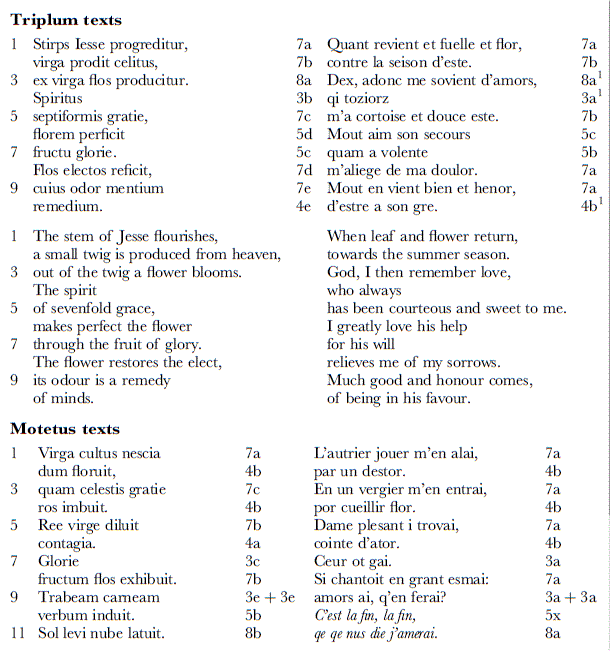 1 A small stem, not knowing the cultivator The other day I went, while it flourished, along a path. 3 which the dew imbued I entered an orchard, with heavenly grace. to cut flowers. 5 The stem washed all the filth I found a pleasant lady, from sinful man. dainty of appearance. 7 The flower brought forth She had a gay heart. the fruit of glory. She was singing in great distress: 9 The word put on I am in love, what shall I do? a stately robe of flesh. It is the end, the end, 11 The sun lies behind a transparent cloud. whatever anyone says I shall love. It is most likely, therefore, that the music of the Flos filius e[ius] 3 clausula originated as a motet. The question remains as to whether this motet was conceived in conjunction with the Latin texts Stirps Iesse/Virga cultus or the French texts Quant revient/L’autrier jouer.These Latin and French texts appear to be related, with identical syllable counts and shared aspects of rhyme scheme (the alternation of rhyme in lines 5‐7 of the triplum, for example, or the use of internal rhyme in line 9 of the motetus): それゆえに、Flos filius e[ius] 3クラウズラの音楽がモテット起源であるということは、大いにあり得ることである。問題は、このモテットがラテン語歌詞Stirps Iesse/Virga cultusとフランス語歌詞Quant revient/L’autrier jouer.のどちらになるのか、ということに絞られる。これらのラテン語ないしフランス語歌詞は、同じシラブルと関連しており、リズム局面もまた共有しているからである。(たとえば、上図line5-7の韻の交代、あるいは、line9におけるmotetus(duplum)におけるline内部の韻の使用など) Other motet texts associated with this musical material are not considered further here. As noted above, Candida virginitas is a contrafactum of L’autrier jouer. The texts Claustrum pudicie and Virgo viget melius are probably the youngest in this motet family. This is the view of both Anderson (The Latin Compositions in Fascicules VII and VIII of W2, pt. 1, pp. 102.3) and Planchart (‘The Flower’s Children’, pp. 334.41), and it is supported by the appearance of this Latin double motet in mensural notation in later sources such as Ba and Hu. こうした音楽材料と関連した他のモテット歌詞は、ここでは考慮されていない。前述のように、Candida virginitas は L’autrier jouerのcontrafactum である。Claustrum pudicie と Virgo viget melius の歌詞は、おそらくは一番あとのものである。これはAnderson とPlanchart両者からの見方である。そしてそれは、Ba写本やHu写本のようなより後期の資料の計量的記譜法で書かれたラテン語の3声モテットの出現によっても支持される。 The musical presentation of Quant revient and L’autrier jouer is arguably more convincing than that of Stirps Iesse and Virga cultus. The French texts are better suited to the quite sectionalised musical delivery in both voices, while semantic units of the Latin texts sometimes span breaks in the melody (as in lines 4‐7, perfections 14‐25, of the triplum, for example). Quant revient とL’autrier jouerの音楽状況は、 Stirps Iesse と Virga cultusのそれよりも、より確信的に論ぜられ得る。2つの声部において、フランス語歌詞は、完全に隔てられた音楽配分に対してより適合させられる。ラテン語歌詞の意味論的単位が旋律をぶち切りながら広がっていくように。(line4-7,perfection14-25 triplum 参照) Musical and textual correspondence is closer in the French motet. The rhymes of two phrases in perfections 19‐20 and 25‐6 of the French motetus, ‘cuer ot gai’ and ‘amors ai’, reflect textually their musical correspondence, while the Latin motetus has ‘glorie’ and ‘trabeam’ (marked by boxes in Examples 10 and 11). 音楽と歌詞の対応はフランス語モテットにおいてより近接している。フランス語のmotetus(duplum)におけるperfections 19‐20 と 25‐6の2つのフレーズの韻、‘cuer ot gai’と ‘amors ai’は、歌詞として、その音楽的対応をも反映する。ラテン語motetusでそれに相当するのは‘glorie’ と ‘trabeam’である。 In addition, the music of perfections 25-8 complements the French text ‘amors ai, q’en ferai?’ very well, with the rising musical phrase mimicking the question ‘what shall I do’? The introduction of the refrain ‘C’est la fin, la fin’ is then set apart musically from this question by the drop of an octave.This shift in register at perfection 29 highlights the presence of the refrain, perhaps also drawing attention to its status as a quotation, and marking the slight change in poetic register. さらに加えて、perfections 25-8につけられた音楽は、疑問文「私は何をすべきか?」をまねするような上昇音型によって、フランス語歌詞‘amors ai, q’en ferai?’を非常によく補っている。refrain ‘C’est la fin, la fin’は、この疑問文部分から、1オクターブ下がった点から始まっている。perfection 29のこのシフトは、refrainの存在のハイライトとなり、おそらくは引用としてのその状況に対する興味を引くことだろう。さらに、詩を書くことにおけるささいな変化もマークすることになるだろう。 In the Latin motetus, the words ‘trabeam carneam verbum induit’ are set to the music of perfections 25-31.This represents a single sense unit; however, the semantic unit is interrupted musically after ‘carneam’ by the break of an octave between perfections 28 and 29. Though ‘trabeam carneam’ mirrors the internal rhyme of ‘amors ai, q’en ferai?’, the rhetorical impact of the French text at this moment is arguably greater. (この部分に相当する)ラテン語のmotetus中の言葉‘trabeam carneam verbum induit’ は、perfections 25-31において音楽付けがされている。しかしながら、意味論的単位は(フランス語歌詞と異なり)音楽的には、perfections 28 と 29との間でオクターブで断裂することになる。rabeam carneam’ は、 ‘amors ai, q’en ferai?’の内部の韻を反映してはいるが、フランス語歌詞のその韻部分のインパクトは、はるかに大きい。 The music of the motetus in particular, then, suggests that it was conceived in conjunction with its accompanying French text. This is further confirmed by the song-like construction of the motetus melody, comprised of pairs of repeated melodic figures (indicated by letters in Example 11). motetus(duplum)の音楽はことに、その付随したフランス語歌詞と一緒に生まれたことを示唆する。このことはさらに、motetus旋律の歌うような作り方(繰り返し旋律)によって確かめられる(Example 11参照))。 While the repetition of melodic patterns is common in clausulae, such repetition is usually of a rather different type, involving the exhaustive exploitation, rhythmic manipulation and transposition of melodic motifs in different harmonic contexts. 旋律の繰り返しパターンは、クラウズラにおいては一般的であるが、徹底した開発、リズム操作、異なったハーモニーの文脈におけるメロディモチーフのtranspositionを含むこうした繰り返しは、通常とは異なるタイプである。 In L’autrier jouer the melodic repetitions are cleverly integrated with the underlying tenor melody, but they are never rhythmically altered and only once (between perfections 19‐.20 and 25‐.6) is a repeated motif transposed. Such a motetus voice, in which melodic repetitions preserve details of rhythm and pitch-level and are, in consequence, clearly audible, is more typical of a vernacular song than of a Latin motet or clausula. L’autrier jouer(motetus)においては、旋律の繰り返しは、tenor旋律を裏打ちしながら、巧妙に統合されている。しかし、それらは決してリズムが変えられたわけではなく、ただ一度、perfections 19‐.20 と 25‐.6において繰り返されるのみである。こうしたmotetusは、そのメロディの繰り返しがリズム、音高を保持し、その結果、聞きやすい状態となっているが、ラテン語モテットあるいはクラウズラよりも、世俗ソングにおいて特徴的である。 It is feasible not only that the music of Flos filius e[ius] 3 originated in conjunction with the texts Quant revient and L’autrier jouer, but also that the exemplar from which the clausula and Latin motet in F were copied was a version of this French motet. This is supported by the context in which Flos filius e[ius] 3 appears in F. The clausula is found in a ‘little appendix’ of three-voice pieces (six clausulae and three organa) beginning on folio 10v, seemingly tagged onto the end of the first fascicle of F after four-voice organum and conductus settings. Flos filius e[ius] 3 の音楽は、Quant revient and L’autrier jouerの歌詞を起源としていただけでなく(注1)、F写本中のクラウズラとラテン語モテットが書写された模範がこのフランス語モテットのversionであったこともまた、あり得ることである。このことは、Flos filius e[ius] 3 がF写本に現れるcontextにおいて支持される。クラウズラは、3声(6つのクラウズラ、3つのオルガヌム)の”小さな付録”において見出される。folio10vから始まり、4声オルガヌムとコンドゥクトゥスの後、F写本中の第一冊子の終わりまで続いている。(注2) 注1) The priority of Quant revient/L’autrier jouer is further confirmed by the presence of two melodic decorations in Stirps Iesse/Virga cultus/FLOS FILIUS E[IUS] absent from Flos filius e[ius] 3 but present in the related French motet in W2 (in perfection 17 of the motetus and perfection 21 of the triplum, circled in Example 10). As Planchart noted (‘The Flower’s Children’, p. 328), Stirps Iesse/Virga cultus does not seem to be related directly to the copy of Stirps Iesse/Virga cultus in W2. This unique Latin motet in F apparently remained relatively independent from the transmission of its extant French counterparts. It is, therefore, unlikely that two widely transmitted melodic details, absent from the related clausula, could have originated in Stirps Iesse/Virga cultus. It seems that these two melodic decorations entered the Latin motet in F via a connection with a French motet version, and that they were omitted from the clausula in F owing to the great difficulty of expressing them in sine littera notation. Quant revient/L’autrier jouer iのpriorityは、さらに、 Flos filius e[ius] 3 にはなく、W2写本 (motetusの perfection 17 とtriplumの perfection 21 example9の青丸印参照)中の関連したフランス語モテットには存在するStirps Iesse/Virga cultus/FLOS FILIUS E[IUS] 中の2箇所の旋律装飾の存在によっても確かめられる。 Planchartが書いたように、Stirps Iesse/Virga cultusはW2写本中のStirps Iesse/Virga cultusのcopyに対しては、直接関係しているようには見えない。F写本中のこの唯一のラテン語モテットは、明らかに、対応する現存のフランス語の伝搬からは独立しているようである。 それゆえ、広く伝搬された2つの(フランス語)旋律が、関連したクラウズラを欠いている状態で、Stirps Iesse/Virga cultus(ラテン語)起源であったということは、あり得ないことである。これらの2か所の旋律装飾は、フランス語版モテットとともにF写本中のラテン語テキストに移植されたことはあり得ることであり、そしてこれらは、 sine littera記譜法においてそうした表現に非常な困難性を負いながら、F写本中のクラウズラでは抹消されたのである。 注2) I borrow Anderson’s term ‘little appendix’. Anderson suggested that, if the clausulae proposed as transcribed motets were ‘gathered together in a little appendix’, then ‘much more credence could be given to the hypothesis’ (‘Clausulae or Transcribed Motets’, pp. 111.12). He qualified his definition of a ‘little appendix’ in a corresponding footnote stating that ‘such ‘‘pockets’’ occur in many MSS. In F we have the 3pt clausulae of fascicule one’ (p. 112, n. 20). 著者はAndersonの言葉 ‘little appendix’を借用している。Andersonは、もしもtranscribeされたモテット群として提案されたクラウズラが「little appendixに集められた」のだとしたら、その時には、より多くの信用がこの仮説には与えられよう、と主張している。彼は、自身の‘little appendix’の定義を、「そのような”ポケット”が多くの写本においては生じているのだ」として資格付けしている。 An organising principle for these three-voice works is not immediately apparent, and their sequence is not liturgical. Yet various links between the initial three clausulae may be discerned. The first three clausulae in this group, their motet concordances in F and W2, and any refrain citations are as follows (see Figure 1 for a facsimile of fol. 11r ): こうした3声作品の構造的原則は直接には存在しない。そしてこれらは儀式的でもない。特に、最初の3つのクラウズラにはさまざまな関連作品が見出される。こうしたグループにおける最初の3つのクラウズラ、そしてそれらに対応するモテット、そして関連するいくつかのrefrainを下記に示す。 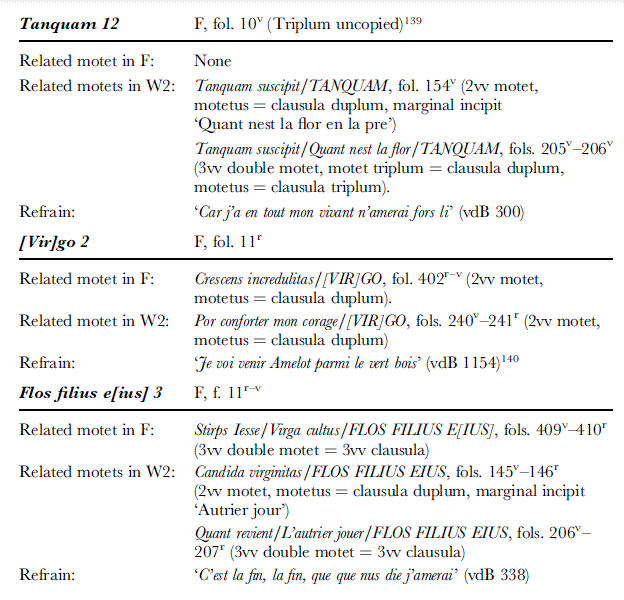 For a discussion of Tanquam 12, see A. K. Zimmermann, Studien zur mittelalterlichen Dreistimmigkeit (Tu¨binger Beitra¨ge zur Musikwissenschaft, 29; Tutzing, 2008), pp. 326.47. Zimmermann suggests that this clausula exhibits the influence of its related motets. See also Baltzer’s analysis of the mixing of first and second modes in the tenor of this clausula (which does not question the priority of this clausula over related motets), in ‘Notation, Rhythm, and Style’, i, pp. 76-81. 注139)Zimmermannは、このクラウズラ(anquam 12)は、その関連したモテットの影響を受けていること明白である、と主張している。 VdB 1154 is not cited outside the context of the text Por conforter mon corage. However, the melody and text of the motetus of Por conforter mon corage are transmitted in R (fol. 102v) as the first stanza of a monophonic chanson avec des refrains attributed to Ernoul le vielle de Gastinois. ‘Je voi venir Amelot’ clearly functions as a refrain in this chanson. Everist has presumed that this refrain originated in the [Vir]go 2 clausula (see French Motets in the Thirteenth Century, p. 70). 注140)VdB 1154は、Por conforter mon corageの歌詞の文脈外では引用されていない。しかし、Por conforter mon corageのmotetusの旋律と歌詞は、トルヴェールであるErnoul le vielle de Gastinoisの作とされるrefrain付きの単旋律シャンソンのfirst stanzaとして、R写本 (fol. 102v) に伝えられている。Je voi venir Amelotは、明らかに、このシャンソンにおいて、refrainとしての機能を果たしている。Everistは、このrefrainは[Vir]go 2 起源であるとしている (see French Motets in the Thirteenth Century, p. 70).。 。 The multiple connections between these initial clausulae in the appendix seem too marked to be purely coincidental. All three of these clausulae are unica in F, and all are related to motets associated with French texts in W2.Furthermore, the dupla of [Vir]go 2 and Flos filius e[ius] 3 contain melodies associated with French refrains in their concluding phrases. これらのappendix中の最初のクラウズラ群は、あまりに注目されているがゆえに、純粋に偶然に取り上げられているように見えない。3つのクラウズラのすべては、F写本に唯一認められるものであり、そして、すべては、W2写本中のフランス語歌詞を持つモテットと関連しているのである。さらにまた、 [Vir]go 2 と Flos filius e[ius] 3のduplumは、それらの決定的なフレーズにおいてフランス語refrainと関連している。 The status of vdB 300 as a genuine refrain in Tanquam 12 is more ambiguous. It has no known concordances, and appears only in the context of this motet, which circulates exclusively as a motet in motet sources, and is not found in any chansonniers. Tanquam 12における真正のrefrainとしてのvdB 300の状況は、よりあいまいである。対応する作品は知られておらず、このモテットの内容にのみ出現する。モテット資料中のモテットとしては循環しているが、シャンソン集には見つけられていない。 The notational irregularities of Tanquam 12 and Flos filius e[ius] 3 were also noted by both Hans Tischler and Edward Roesner,142 and more recently Ann Katrin Zimmermann has observed that ‘these clausulae at the end of the first fascicle of F vary significantly from untexted three-voice passages of discant’: she stated that the nature of their three-part texture (‘Dreistimmigkeit’) seemed to ‘emerge out of the context of motets’. Tanquam 12 and Flos filius e[ius] 3 における記譜法の不規則性は、Hans Tischler and Edward Roesnerによって述べられた。より最近では、Ann Katrin Zimmermannが「F写本の第一冊子の最後に位置するクラウズラ群は、歌詞がついていない3声のディスカント形式とは異なるものである」と観測している。彼女は、これら3声textureは「モテットの文脈から出現した」としている。 Tanquam 12 and Flos filius e[ius] 3 are strong candidates for ‘transcribed motets’144, independently of any suspicion that they might be part of a ‘little appendix’ of works of this type; and the fundamental priority of the clausula [Vir]go 2 over its related motet versions has also been challenged.145 Tanquam 12 と Flos filius e[ius] 3は、これらがこのタイプの作品としての‘little appendix’の一部であるかもしれないといういくつかの疑問とは独立して、transcribed motets候補であることが強く予想されている作品である。そして、関連したモテットを超えて、 [Vir]go 2クラウズラのもともとのpriorityが考えられたのである。 Heinrich Husmann suggested in 1940 that the copyist of Tanquam 12 created this clausula from a motet version. Although neither Tanquam 12 nor Flos flius e[ius] 3 was proposed as a transcribed motet by Waite (see The Rhythm of Twelfth-Century Polyphony, p. 101), both meet his criteria. Frobenius also believed Tanquam 12 to be a transcribed motet on grounds of its peculiar transmission in F, and the presence of refrain quotations. See the discussion of Sm 97 in ‘Zum genetischen Verha ¨ltnis’, p. 19. (注144) Heinrich Husmann は1940年に、Tanquam 12 の書記は、このクラウズラをモテット版から作り上げた、と主張した。Tanquam 12 も Flos flius e[ius] 3 も、Waiteによって、 transcribed motet であると提案されたが、それは両者ともに、彼の基準に合致したからである。Frobeniusもまた Tanquam 12 はF写本中に伝達された特殊な状況とrefrainの引用におけるtranscribed motet であると信じていた。 While the rest of this group of pieces at the end of fascicle 1 lack related motets, the choice and order of the first three clausulae is potentially signifcant. Their appearance alongside one another in F could be explained if they were copied in conjunction with a French motet source. 第一冊子の終わりにあるこのグループの残りの作品が関連したモテットを欠いているが、最初の三つのクラウズラの選択と順番が潜在的に重要である。これらの作品がF写本中に並んで存在しているのは、これらがフランス語モテット資料と一緒に筆写されたかどうかによって説明が可能となるであろう。 The first line of text of the (uncopied) triplum of the French motet on TANQUAM is Quant nest la flor,146 the motet on [Vir]go 2 is Por conforter mon corage, and the motet triplum on Flos flius e[ius] 3 is Quant revient et fuelle et flor. TANQUAM上のフランス語モテットのtriplumの歌詞の最初のlineはQuant nest la florであるが、 [Vir]go 2上のモテットは、Por conforter mon corageであり、Flos flius e[ius] 3上のモテットのtriplumはQuant revient et fuelle et florである。 As these three texts begin with ‘Q’ and ‘P’ they would probably have been neighbouring pieces in an alphabetically ordered collection of French motets.147 The disturbance to the alphabetical ordering of these pieces in F (where the clausula corresponding to Quant nest la flor appears before that for Por conforter mon corage) could have resulted from a desire to begin the appendix appropriately with a clausula on TANQUAM, the Christmas tenor that also opens the first motet fascicle of F. これらの三つの作品はQ,Pで始まるが、それらはおそらくは、フランス語モテットのアルファベット順として隣同士となっているものと思われる。注(147) F写本におけるこれらの作品のアルファベット順の乱れは、F写本中のモテット冊子の始まりがクリスマスであり、そのtenorであるTANQUAMによるクラウズラを適切な場所において、appendixを始めたいという願いの結果であろう。 That Quant nest la flor and Quant revient et fuelle et flor are three-voice double motets, while Por conforter mon corage is for tenor and motetus only, would not prevent these works from appearing together in a motet collection. The upper voices of these double motets would probably have been notated as successive parts alongside two-voice motets, just as they are in the ninth fascicle of F. 注147)Quant nest la flor と Quant revient et fuelle et flor が3声のモテットであり、or conforter mon corageが2声のモテットであるということは、モテットコレクションにおいて一緒に存在していることが不自然である、ということではない。これらの3声モテットのtriplumは、2声モテットに引き続いて書かれたものと思われる。 I have called attention to a number of features of this Flos filius eius motet family that are difficult to account for under conventional chronological models. . These features can be most convincingly and simply explained by concluding that Quant revient/L’autrier jouer/FLOS FILIUS EIUS was transcribed as a clausula and furnished with the Latin contrafactum Stirps Iesse/Virga cultus/FLOS FILIUS E[IUS] in F. 私は、伝統的年代史的モデルにおいては説明が難しいこのFlos flius eiusのモテットグループの多くの特徴に注意を払っている。これらの特徴は、Quant revient/L’autrier jouer/FLOS FILIUS EIUS がクラウズラとしてtranscribeされ、ラテン語のcontrafactumであるStirps Iesse/Virga cultus/FLOS FILIUS E[IUS] が付与されていると結論づけることによって、確信的かつ単純に説明されることが可能である。 If this is accepted, then understandings of the refrain ‘C’est la fin, la fin’ must be revised. The French motet from which I believe Flos filius e[ius] 3 descended (and may even have been copied) would have contained both the music and text of this refrain. ‘C’est la fin, la fin’ could have been formulated in the process of creating Quant revient/L’autrier jouer/FLOS FILIUS EIUS, whose music was, it seems, newly composed in conjunction with its text. もしもこの結論が受け入れられるのであれば、refrain ‘C’est la fin, la fin’の理解は改められることであろう。私がクラウズラFlos filius e[ius] 3 由来であると信じているフランス語モテットは、このrefrainの音楽と歌詞の両方を含んでいる。‘C’est la fin, la fin’ は、Quant revient/L’autrier jouer/FLOS FILIUS EIUS,の生成過程において策定されたと考えることができる。その音楽は、その歌詞に合致するように新たに作られたのであろう。 Given the wide transmission of this refrain, however, it is perhaps more likely that the musical and textual phrase already had the status of a refrain, representing a genuine citation at the end of the motetus. In either case, ‘C’est la ?n, la ?n’ can no longer be considered an important example of a widely disseminated refrain believed to derive from a clausula. このrefrainの広範囲な伝播により、しかしながら、その音楽と歌詞のフレーズがすでに、motetusの最後で純正な引用を形取っていたrefrainの性質を持つようになっていた、ということはおそらくは、大いにあり得ることである。 |